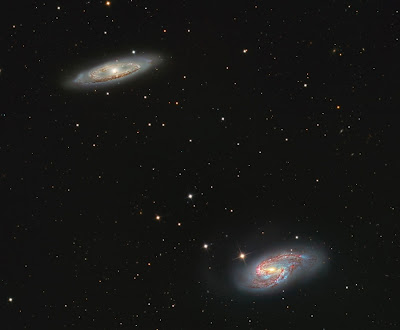

| Visitors Now: | |
| Total Visits: | |
| Total Stories: |

| Story Views | |
| Now: | |
| Last Hour: | |
| Last 24 Hours: | |
| Total: | |
Chet Raymo, “Blur”
by Chet Raymo
“This was not one of the more spectacular of the APODs (Astronomy Pictures of the Day), but it caught my attention (click to enlarge). Two spiral galaxies, with rich dust lanes, one more tightly bound than the other, more or less twins of our own Milky Way Galaxy. M65, at upper left, and M66 at lower right, two of the 110 fuzzy blurs in Charles Messier’s 1784 catalog of fuzzy telescopic blurs. Messier was a comet hunter- that is, a seeker of blurs. He compiled his list of stationary blurs so as not to mistake them for comets. Comets are part of our solar system, and move across the sky from night to night. The objects in Messier’s catalog are far beyond the solar system – gassy nebulas or star clusters in the Milky Way Galaxy, globular clusters of stars near the Milky Way, or other galaxies. Messier knew none of this. A blur was a blur.
The scattered stars you see in the photograph are very much in the foreground, part of our own galaxy. Think of the Milky Way as the galaxy at upper left. Our Sun is about two-thirds of the way out from the center, just on the inside of a spiral arm, in about the middle of the disk. When we are looking toward Leo, we are looking straight up out of the disk, through a thousand light-years of Milky Way stars. Then, empty space until we get to M65 and M66.
If the Milky Way Galaxy were a dinner plate, M65 and M66 would be two other dinner plates about as far away as the length of a football field. The foreground stars are in our dinner plate, then a vast emptiness between us and the two other “island universes.” None of what you see in the photograph is visible to the unaided eye– neither the foreground stars, nor the galaxies.
It is just possible to imagine that humans might someday visit one of the nearest stars in the Milky Way, with– presumably- its own family of planets. The other hundreds of billions of dinner plates with their myriad of worlds are forever beyond our visitation. Giordano Bruno went to the stake for imagining (among other heresies) a plurality of worlds. His executioners didn’t know the half of it. Or the other hundred-billionth of it.
Anyone who grasps the significance of the photo above and claims to have a “personal relationship” with the creator is either staggeringly delusional or luckier than me.”
2012-10-03 22:34:06
Source: http://coyoteprime-runningcauseicantfly.blogspot.com/2012/10/chet-raymo-blur.html
Source:



